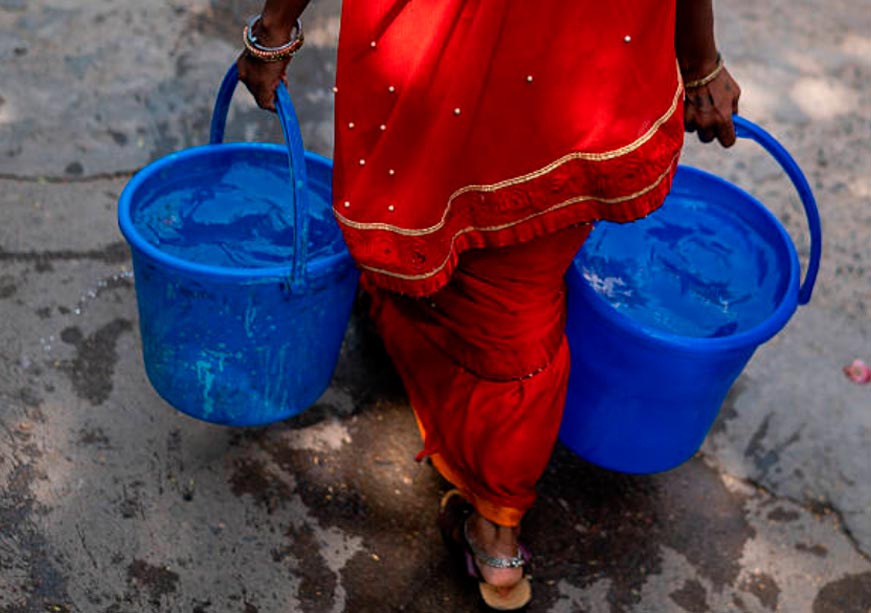-
CENTRES
Progammes & Centres
Location
High water losses are widening the supply gap, forcing costly and unsustainable fixes across Global South cities.

Image Source: Getty Images
This article is a part of the essay series: World Water Week 2025
By 2047, over half of India’s 1.4 billion people are expected to live in cities, brewing apprehensions and placing unprecedented pressure on an already stressed urban water system. The present, too, is precarious: five of the world’s 20 most water-stressed cities are in India, with Delhi ranked second after Tokyo, followed by Mexico City, Shanghai, Beijing, and Kolkata in the third, fourth, and fifth places, respectively. Studies estimate that urban India’s supply-demand gap for fresh water could reach 500 billion litres daily by 2030, driving more groundwater extraction. Additionally, growing water stress in urban India threatens to erode 6 percent of India’s Gross Domestic Product (GDP) by 2050. Cities across most emerging economies face a similar ominous future.
India’s urban utilities lose an average of 38 percent of potable water to NRW, which is almost double the global acceptable benchmark of 15-20 percent.
Given this scenario, cities must make the most optimal use of their available water resources and, more importantly, ensure that they reduce their high rates of Non-Revenue Water (NRW). NRW refers to treated water that is fed into the distribution system but is lost before it reaches the consumer, either through physical losses (leaks and distribution losses) or apparent losses (theft, unmetered usage, or inaccurate billing). Studies have revealed that physical loss through systemic leaks accounts for ~75 percent of NRW in South Asian cities. India’s urban utilities lose an average of 38 percent of potable water to NRW, which is almost double the global acceptable benchmark of 15-20 percent.
Delhi, with a ~58 percent NRW, is also India’s NRW capital. The Delhi Jal Board fails to account for more than 2,400 Megalitres per day (MLD) of the total 4,207 MLD of supply, which includes the unbilled water supply to Juggi-Jhopri (JJ) clusters and unauthorised colonies. Furthermore, Mumbai—with a 30 percent NRW—loses an enormous 1,155 MLD of its total water supply of 3,950 MLD. To contextualise, a 30 percent NRW means Mumbai loses nearly three times more water than the 455 MLD it fetches from the ~INR 30 billion Middle Vaitarna dam—commissioned in 2014–15—on a daily basis. Despite opting for capital-intensive desalination, Chennai faces a demand-supply gap of 1,200 MLD, with media reports pegging the NRW of up to 30 percent.
The situation is similar in the other metropolitan cities, including Bengaluru, Kolkata, and Hyderabad, where local governments are relatively better resourced. Across the country, hundreds of Tier-1 and 2 cities with much weaker civic infrastructure could be losing billions of litres of water as NRW.
Studies have estimated the global volume of NRW at 346 trillion litres daily. Utilities in the developing world contribute to one-third of this NRW, which, if saved, would cater to the needs of 800 million people at 150 litres per capita per day.
Most cities in emerging economies also reflect high NRW disparities within the cities and their suburban districts. For example, several distribution zones in Kigali record more than 55 percent NRW, which is much higher than the city’s average of 39 percent. Addis Ababa’s real losses account for 64 percent of the overall ~42 percent NRW. The city’s 620,000 service connections record an average of 300 litres of unbilled water per connection per day.
Most cities in emerging economies also reflect high NRW disparities within the cities and their suburban districts.
Developing countries in Asia showcase a similar trend. The World Bank estimates a 60 percent NRW in Karachi with a demand-supply gap of 700 MLD. Reducing the NRW level to the international benchmark can save ~1,200 MLD, thereby not only bridging the current shortfall but also making Karachi water surplus. With a service coverage area of just 66.7 percent, Jakarta’s NRW level is 45.6 percent, while Yangon, with 45 percent water supply coverage, records ~50 percent NRW. Assessments by various multilateral agencies have revealed high NRW levels even in various West Asian countries, including Lebanon (60 percent), Jordan (50 percent), and Iraq (60 percent).
Similarly, Brazil has the highest NRW in Latin America and the Caribbean, with its public utilities losing 37.8 percent of all water produced in 2022. However, Brazil has wide disparities within NRW among its 27 federal units, with Goiás at 28.5 percent (lowest), and Amapá at 74.6 percent (highest).
Much of the urban water infrastructure, over half a century old, is crumbling. For example, the old areas of Hyderabad, such as Gandipet, Manjeera, and Singur, contribute to 90 MLD water loss. Old areas in South Mumbai face a similar challenge.
Ageing infrastructure, poor maintenance, and capacity constraints to undertake prompt repairs contribute to low system efficiency and high levels of NRW in other Global South cities. According to a 2019 study, 2,115 utilities from 46 countries emphasised universal water meters to measure and regulate water use and leaks, and prepare targeted NRW reduction strategies. However, only about 50 percent of India’s urban households are equipped with functional water meters, making it virtually impossible to track consumption or detect anomalies. Consequently, illegal connections and unmetered consumption are rarely monitored or penalised.
Water authorities, municipal bodies, and state departments often operate in silos, without a unified NRW reduction strategy. The lack of skilled personnel and modern equipment further compounds the problem, as few utilities have the financial or human capital needed to mount an effective response without institutional support.
Reducing NRW is an urgent climate imperative. Given the energy-intensive production, treatment and conveyance of water, every litre of water lost through leaks translates into a substantial increase in greenhouse gas emissions, especially in cities that rely on thermal power.
Additionally, NRW indicates corrosive water mains, which are easily prone to contamination from leaky underground sewage systems, especially in cities with intermittent water supply at different times of the day across different distribution areas. The pipes lose pressure when the supply stops, allowing seepage of contaminated groundwater.
Every litre of water lost through leaks translates into a substantial increase in greenhouse gas emissions, especially in cities that rely on thermal power.
Water losses widen the demand–supply gap, driving environmentally damaging and carbon-intensive responses such as building reservoirs and dams that cause displacement and deforestation; energy-intensive treatment and long-distance pumping; mega investments in desalination plants; overextraction of groundwater; and greater reliance on water tankers, particularly among low-income groups. Each of these externalities triggers socio-ecological challenges.
Ironically, a few emerging economies also present some of the global best practices. Dhaka, with a 2,900 MLD supply, stands out for its remarkable NRW reduction from 40 percent to an impressive 5 percent. Concerted efforts over two decades, coupled with universal metering, have ensured a stirring 98 percent revenue collection, allowing Dhaka’s utility to prioritise water access for low-income communities and achieve an exceptional operating ratio of 0.66. Similarly, Manila Water reduced its NRW from 63 percent in 1997 to 12.69 percent in 2022, making it one of the world’s most water-efficient urban centres. Similarly, in India, the Jamshedpur Utilities and Services Company Limited (JUSCO) achieved a notable NRW reduction from 36 percent to 10 percent.
Addressing the NRW crisis requires close coordination between municipal and state governments, underpinned by robust reforms. One foundational step is to establish district metered areas (DMAs), which divide the water supply system into manageable zones, facilitating real-time monitoring of inflow and outflow. By enabling leak detection and pressure regulation, DMAs in cities like Malatya in Turkey, with a division of its distribution network into 31 separate DMAs, led to NRW reduction from 80 percent to an average of 30 percent. In 2014, Türkiye’s regulatory framework prioritised nationwide efforts to reduce NRW to 25 percent. Establishing 75 DMAs for efficient water management also made a significant contribution to NRW reduction in Jamshedpur.
Equally important is the universal implementation of tamper-proof, smart water metering that generates real-time data, integrated with Geographic Information System (GIS) Mapping and Supervisory Control and Data Acquisition (SCADA) systems to ensure seamless monitoring, analysis, and rapid response.
Utilities must also establish dedicated NRW cells, empowered through specific amendments to the Municipal Acts and equipped with mobile teams, leak detection tools, and performance-based targets.
Simultaneously, governments must promote public-private partnerships (PPPs) for NRW reduction. Cities such as Manila, Phnom Penh, Nagpur, and Jamshedpur show how private sector participation can bring in the necessary expertise, innovation, and accountability.
Local governments must embed NRW reduction strategies within broader city-level climate action plans, ensuring access to international climate finance from the Green Climate Fund and the Adaptation Fund.
Municipalities must also publish NRW data and progress indicators on digital dashboards to foster accountability and build citizen awareness and trust, critical for any long-term governance reform.
As sea levels rise, rains become erratic, and aquifers shrink, cities in the Global South cannot afford high NRW levels.
As sea levels rise, rains become erratic, and aquifers shrink, cities in the Global South cannot afford high NRW levels. They must prioritise NRW reduction on the climate action agenda, with well-defined targets to achieve immediate gains in water availability, reduce emissions, and improve water and air quality, while strengthening the utilities’ financial sustainability. World Water Week 2025 calls for cities to move from pledges to practice and centre-stage water for climate action. There is no better starting point than plugging NRW’s silent drain for building climate-resilient cities.
Dhaval Desai is a Senior Fellow and Vice President at the Observer Research Foundation.
The views expressed above belong to the author(s). ORF research and analyses now available on Telegram! Click here to access our curated content — blogs, longforms and interviews.

Dhaval is Senior Fellow and Vice President at Observer Research Foundation, Mumbai. His spectrum of work covers diverse topics ranging from urban renewal to international ...
Read More +